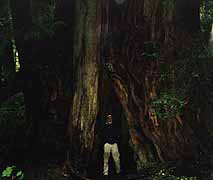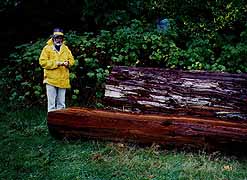American Sabbatical 034: 10/17/96
Rainforest
10/17.. Rainforest
It was gray and blowing scud hard southerly when we woke in Forks, and it was driving rain
by the time we saddled up. Washington was determined to give us
our money’s worth. We headed down the west coast with the change
of season in our faces.
The weather didn’t slow the logging operations, and the big rigs
kept breathing down our necks or blowing by us in clouds of spray.
The log jockeys pull tandem trailers loaded with 30-foot sticks,
or singles with 60’s piled high in the bunks. Running back empty
they pile the second trailer on the first and jack up the mph.
We were running through alternating aisles of cathedral forest
and vistas of rolling second growth, with freshcuts of Armageddon
for punctuation. The loggers’ sign propaganda began to work on
me. “Replanted 1967” had dense growths of 100-foot trees. “Replanted
1982” was thick with 20-footers. The woods certainly come back.
Is this any different than our garden? Should we be selective
harvesting our veggies, leaving mixed stands of old growth, instead
of pulling it all up each year and replanting? Is clearcutting
somehow different than running combines through the corn? The
smoldering piles of slash and roots in the ripped landscape argue
for alternate practices, but the thought of trying to selectively
cut in the dense stands on the upthrust slopes puts me in the
loggers’ camp.
| Red Owl flew through some live shows close to the road, with telescoping
rigging towers stabbing the sky, and cables running down the slopes,
yarding up the big sticks with a running jerk. Then we’d plunge
back into the dark tunnels of fir and spruce and cedar. The wind
was lashing the tops and the small stuff was thrashing and trembling. |

Sea Stacks
|
Our first sidestep was down to Ruby Beach, where we climbed down
through 150-foot firs to the back beach .. headhigh in salal and
blackberry.. then pushed out into the wreckage of a giant’s pickup-sticks
game. Rafted piles of immense logs scattered willynilly along
the surfline. We clambered over the slick wreckage to the sloping
beach. It was pouring precip and our shouted breaths of steam
were ripped away by the gusting wind. Just offshore stone towers
were girded with tossing surf, and we caught glimpses of Destruction
Island through the squalls. We tromped the mixed pebbly sands
until we were soaked sufficiently, then retreated to our owl roost.

Big Cedar
|
We were in the Olympic National Forest now and the growth tended
to be older and nobler. Grandfather trees with gigantic children
around them. We swung up a sideroad to “Big Cedar”, and the wind
continued to rise. The trees were throwing branches onto the pavement,
and we tiptoed into the old woods. These antique monster cedars,
they said, were 1000 years old. The two most ancient were long
dead hollow hulks rising like mythic chimneys for 100 feet or
more. Standing inside THE Big Cedar with a storm raging outside
was a journey out of time. Peggy called me out and we turtlenecked
onto the beaten path again. |
We’d wanted to see the rainforest and this was RAINforest with
bells on. Red Owl was lurching with the drenching gusts. The wind
had backed into the east and was pushing 55mph, sideways. Black
mountains appeared and disappeared to windward, and we could see
pillars of cloud pluming up the gullies and through the valleys,
between downpours. And the logging rigs thundered past.
| Our next mission was to find “The World’s Oldest Spruce Tree.”
Ain’t America grand? Biggest. Tallest. Longest. Oldest. Best.
Not just a 191-foot sitka spruce, but the biggest.. oldest.. greatest
spruce on the planet. And it IS a mother of a tree. A behemoth,
brother. I can see tree worship in this country. That dead cedar
fluted me up into other regions, and this hoodoo spruce is still
alive and, well, reaching for the sunlight. 59 feet around, old
Sitka herself was seeded about the time of the battle of Hastings. |

Rainforest Postcard
(Willard Clay Photo)
|
So how do you have the manifest destiny of clearcut harvesting
together with the evolved destiny of ancient woods? Will there
only be the protected parkland stands where us treehuggers can
go worship, and 50 year rotation in the commercial plantation,
so we can have telephone poles and studding? Kelly (raised to
be a logger) said the Indian loggers on Galiano fell timber with
the best of them, but with reverence. And they won’t cut the trees
of power. Can we all learn to respect the old truth of the woods?
This puzzle is too deep for me today, I’ll just hold the Owl on
the road and roll on.
As the day declined, the deadheading doubles grew more numerous,
and there were occasional gangs of loggers finishing up the day
by the road. We ran through a big show where crews were cleaning
up the highway after felling some giants onto it, and the slash
hills were blazing, sending spirals of steam and smoke cartwheeling
into the storm. One rangy logger was leaning on a big rig and
having a smoke with the driver. Long and lanky in his rubber pants,
plaid shirt, and yellow hardhat, sporting a bushy black beard,
he was the picture of labor at ease. Big grin, huge frame slack
but not slumping. A woods athlete after a day’s run. And if we
didn’t have the logging shows, and the cowboy fisheries, and the
like, where would a young guy like this get to feel his muscles
sing? Mansong of the big woods.

Carving Stock
|
Another thing the large lumps of cellulite have engendered: there’s
more, and better, chainsaw sculpture by the road in the Olympics
than we’ve every seen. My favorites are the big fishmen between
Clallam Bay and Neah. When you’ve got hunks of cedar 6-foot across
to work with, it’s hard not to think monumental. But the crowning
artform in this corner may be the welded and torchcut steel figures
in Raymond. Lifesize cutouts of wildlife in 2-inch plate steel,
rendered in lifelike perfection, and playful welded-up groups
of people and animals, lined the highway and the byways of this
otherwise unremarkable town. Hurrah for Raymond, even in the rain. |
We rolled out of the big woods at Aberdeen, a town as ugly as
a drunken loggers’ dream, and the land got tamer.. but not the
weather. There’s still plenty of forest between the Chehalis and
the Columbia, but you can feel the mountains receding behind you,
and the ocean invading the hills. Swamps and marshes cut the coastal
plains, and the second growth on the hills is mixed hardwoods
along with the money trees.
As we approached the mouth of the Columbia, that treacherous pass,
the skies did a war-dance to shake our bones. Full storm raging
as we inched our way through the sheets of rain into Longbeach,
the OOB (Old Orchard Beach) of Washington. We were back in civilization,
if we could find it. We found a 3-story Super-8 with offseason
rates and a view of the Pacific hurling itself at America. Hope
you’re home and dry.
|
The original e-mails we sent from the road often had personal
asides to various fellow-travelers, particularly about computer
communications. To give you the flavor, here's a sidebar from
our night at Long Beach:
"So here I am lying on my back under the counter in a motel room
taking apart the phone jack with my pocketknife in order to plug-in
and yak at you. Being wagonmaster on the E-train has put all my
techiness to the test. The world isn’t quite ready for us cybernauts
yet. Sometimes the motel phones are hardwired (like tonight),
sometimes you have to dial 9 (or 8) to get an outside line, sometimes
the switchboard is old and slow, or still pulse-dial. So as soon
as we check into someplace with a phone, I try to jack-in, program
the modem, and pick up our E-mail. I now plug a splitter into
the jack (if any) so the phone and the puter are both hooked up.
Ever since I sent an evening dispatch telling what motel I was
in, and Willy Drislane tried all night to call (but couldn’t get
through because I hadn’t hooked the phone back up), I’ve kept
both connected.
To outsmart the old phone equipment I’ve reconfigured the modem
string so that it waits 7 seconds before trying to connect with
the server. An AOL tech led me through that reprogramming after
I called for help on their 800 number, and I don’t recommend calling
for help. It takes at least half an hour to get through to a tech,
who may be helpful, and you have to hangup to try what they suggest
.. then wait another halfhour for another tech. I’ve discovered
that most automated switchboards will switch you to an outside
line where you can dial an 800 number, no matter what the signs
or the front desk says.. just play with preface numbers. I’ve
given up trying to use AOL local numbers. I simply use their 800
number (and pay 10 cents a minute). The longest it’s taken me
yet to send and receive mail is 5 minutes. But I haven’t come
up with a way to get around a whiny dialtone.
All told, however, we seem to have the comms working QRK5 (loud
and clear). There are about 30 of you on the E-train (counting
everyone talking back). We are overwhelmed with good suggestions
for people and places to see on the west coast, and if we don’t
make the connections we are still grateful for the help. It’s
fun to have you looking over our shoulders. I find writing a personal
log with all of you in the room much like changing clothes at
the beach.. oops what did I show? It’s a special treat that so
many of you are playing with this medium for the first time with
us. It’s suspect terrain, isn’t it? Look out for the quicksand." |
|
(Memo #32)
Oct. 18 - KITES KITES KITES
WHO? Knights of Mangha and other kite-flying aficionados
WHAT? World Kite Museum and Hall of Fame
WHERE ? Long Beach, Washington
WHEN? yearly Kite Festival today, kite competitions
HOW? with strings attached
Topics: Fighter kites, Knights of the Manjha, Rokkaku,
Questions: Can kites solve world problems? What if the Crips and
Bloods were Knights of the Manjha? Are kites pastimes or weapons
of war ? |

Warrior Kite
|
When I was a child in Connecticut, every Easter was kite-flying
day. My mother had friends who lived next to a dairy farm and
we would gather in the great field, kites ready. It was always
raw on Easter and my hands would get really cold. I remember the
thrill when I got my kite up, way way up high.
Long Beach, Washington, which bills itself as the “Longest Beach
in the World”, hosts a yearly kiteflying contest each August.
This has been fostered by the same folks who established the World
Kite Museum and Hall of Fame in a small house off the main street
of this seaside town. It contains a huge collection of kites with
gems of kite lore. Other stores on Main Street specialize in kites.

Mangha
|
A video introduced me to mangha, the art of kite combat. Fighter
kites are flown in serious competitions where the aim is to cut
opponents’ strings until the victor has the only kite aloft. These
kites’ strings are coated in ground glass (!) The Caribbean fighter
kites have razors near their tails. The competitions are run by
trained referees according to strict rules. There is a spirit
of chivalry. Courtesy and good sportsmanship are keys; the competitors
must be friendly and shake hands at the end. The sport has been
introduced to Europe by Indonesians living in Holland (which has
26 mangha clubs). There is now an international mangha club and
an American Kite Association. Mangha has become a spectator sport
in the west with flyers standing in one area. In Asia kite flyers
may be out of sight of each other. |
The kite collection was divided by nationality, as traditions,
shape, materials, and size vary. Kites were first used in Asia
over 2000 years ago, and India, Japan, Korea, Indonesia seem to
be the centers of kite mania. Kites are flown on specific ritual
occasions. Makar Sanskranti (when the Gods wake) is the holiday
in mid January when kites are flown in India. In Korea on the
15th day of the new year kites are released with the message “bad
luck away, good luck stay”. In Nepal kites are flown after the
rice harvest festival. In Thailand kites are flown by club teams
and there is an annual Royal Cup competition. Japan has four main
styles of kites and an extensive culture surrounding them. Hamamatsu
kite battles have been going on for over 400 years on Boys’ Day
(when the low-status children of a neighborhood cut the kite strings
of the local samurai’s children). Shironi kites are part of a
competition between farmers at rice planting. Kites have evolved
from rice paper and bamboo Asian forms to high tech models of
mylar, silk, even strings coated with diamond powder.
I AM NOT MAKING THIS UP. We arrived in Long Beach in a storm.
By morning the rain was intermittent. As I was watching the video
on kites, there was a huge crash outside. The fire station siren
started blaring and I heard the fire trucks go out. Lightning
had hit the Long Beach school; we saw the smoke and fire engines
as we drove out of town. Ben Franklin obviously didn’t want me
to associate kites with frivolity. Kites are serious aids to science
and warfare. (In the 17th century the Japanese attacked a much
resented Dutch fort by flying a kite shaped like the Dutch flag
carrying explosives over the fort’s walls!)
|

Kite poster
|






